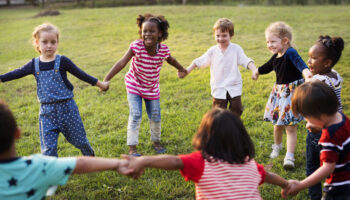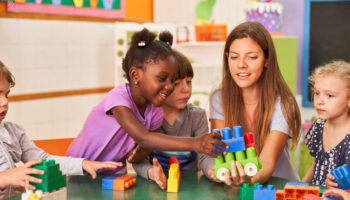Erin DelRegno
Circle time in many classrooms still looks like this: calendar (month, year, counting the days) and days of the week. Time concepts, however, are abstract to children. They can’t see them, so they are hard for them to understand. To them, tomorrow can mean two weeks from now. They cannot grasp days of the week. They can recite them, but they don’t understand what they mean.
Circle time has stayed like this even though research has shown that children benefit more from small-group activities and free-play periods, since they can experiment, explore, and learn by doing. This is where real learning takes place.
You can make circle time into so much more than just calendar. You can add engaging learning activities and so much more language and discussion into the children’s day.
Getting started:
- Think about when it is scheduled. If children were just sitting at the table for something else, don’t expect them to come sit on the carpet and remain focused.
- Be Intentional! Prepare and plan.
- Preschool children’s attention spans are still developing. Expectations for them to sit in circle should be 5-10 minutes. You can always extend it if they are truly interested and want to do more.
- Let them move. Some children must wiggle. They are not going to sit still and ‘crisscross applesauce’ the whole time.
- Have other activities available for children. Do not force anyone to participate if they are not interested.
- Be interested and excited about what you are discussing or doing! If you are excited, the children will get excited.
- Be flexible and add their ideas/choices into what you are doing. They are more actively engaged when you contribute their ideas.
- Follow the cues of the children. If the activity is not engaging or is just not working, change what you are doing.
Expand and enhance your circle time with:
- Easy-to join activities
- Songs, finger plays, chants, poems
- Storytelling and re-enacting stories and nursery rhymes
- Learning how to handle social issues through problem solving during role play, discussions, puppet shows
- Movement activities (with or without music or objects)
- Cooperative games (playing with one another instead of against each other)
If you still want to use the calendar itself, make it more meaningful to the children. Discuss events that are important to the classroom community (birthdays, an activity they will be doing that day, changes in the routine that day). Make sure to include visuals. They will help children understand what you are explaining.
How children behave and how they are engaged in circle time is often directly related to the activities offered. The level of preparation can make a difference. You want to be very intentional with what you plan. Make it something the children will want to do (not something they, or you, must do).
Check out the following link to an article, written by a preschool teacher, giving ten tips for taking circle time from just a routine experience to an engaging and interesting experience in the preschool classroom. This is a great article with explanations for each tip and pictures!
Teach Preschool – Ten Tips for Circletime
References:
Stewart, D. J., M.Ed. (2013, March 25). 10 Tips for Circletime. Teach Preschool, LLC. Retrieved from http://www.teachpreschool.org/2013/03/25/ten-tips-for-circletime/
Teach Preschool
Beneke, S. J., Ostrosky, M. M., & Katz, L. G. (2008, May). Calendar Time for Young Children: Good Intentions Gone Awry. Young Children (NAEYC), 12-16. Retrieved from http://www.naeyc.org/files/tyc/file/CalendarTime.pdf
Understanding Large-Group Time. (2013, April 5). HighScope, 353-362. Retrieved from http://www.highscope.org/ProductCart/pc/catalog/samplepagestoc/hspc_sample.pdf




